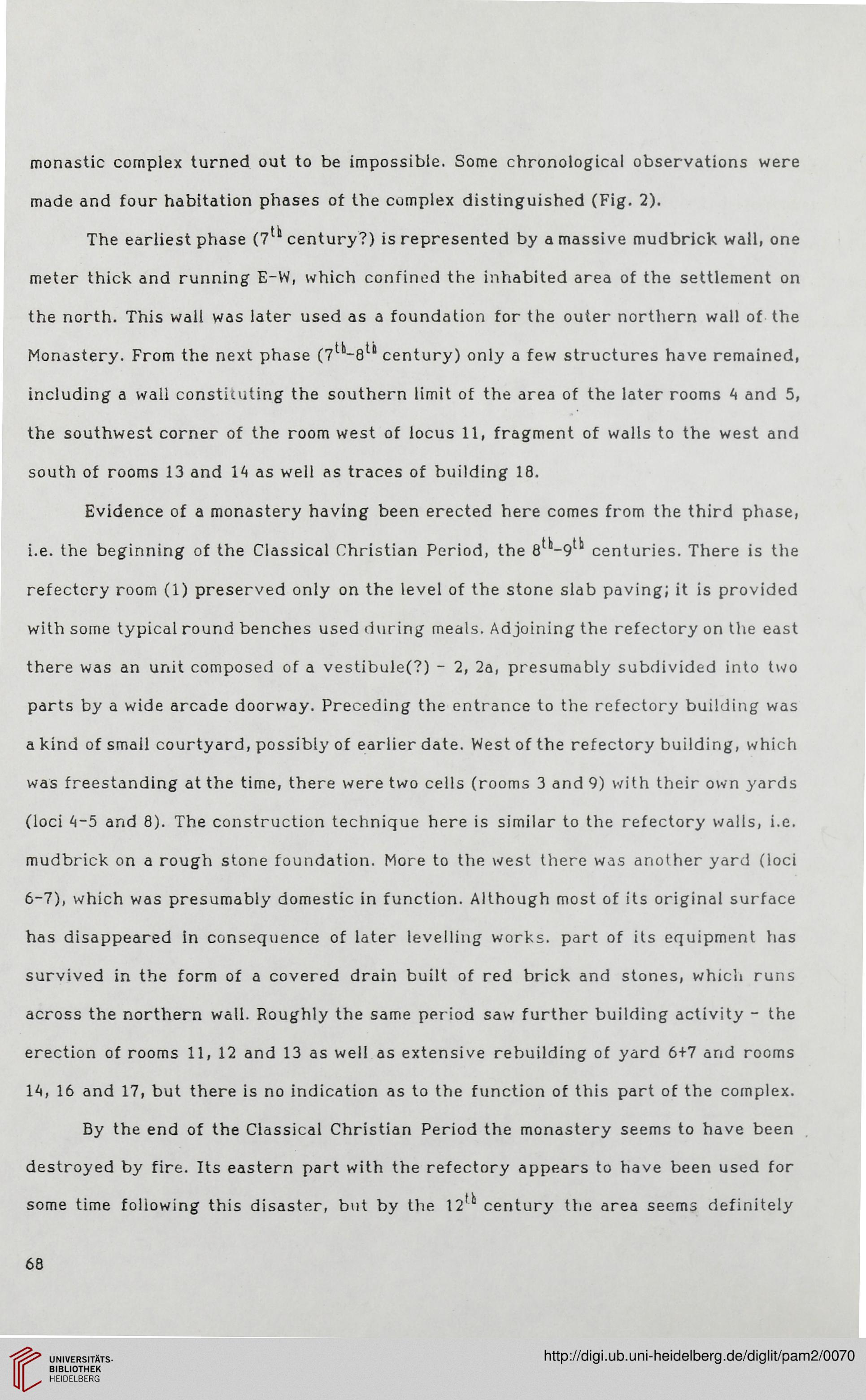monastic complex turned out to be impossible. Some chronological observations were
made and four habitation phases of the complex distinguished (Fig. 2).
The earliest phase (7^century?) is represented by a massive mudbrick wall, one
meter thick and running E-W, which confined the inhabited area of the settlement on
the north. This wall was later used as a foundation for the outer northern wall of the
Monastery. From the next phase (7tk-8^ century) only a few structures have remained,
including a wall constituting the southern limit of the area of the later rooms 4 and 5,
the southwest corner of the room west of locus 11, fragment of walls to the west and
south of rooms 13 and 14 as well as traces of building 18.
Evidence of a monastery having been erected here comes from the third phase,
i.e. the beginning of the Classical Christian Period, the 8^-9^ centuries. There is the
refectory room (1) preserved only on the level of the stone slab paving; it is provided
with some typical round benches used during meals. Adjoining the refectory on the east
there was an unit composed of a vestibule(?) - 2, 2a, presumably subdivided into two
parts by a wide arcade doorway. Preceding the entrance to the refectory building was
a kind of small courtyard, possibly of earlier date. West of the refectory building, which
was freestanding at the time, there were two cells (rooms 3 and 9) with their own yards
(loci 4-5 and 8). The construction technique here is similar to the refectory walls, i.e.
mudbrick on a rough stone foundation. More to the west there was another yard (loci
6-7), which was presumably domestic in function. Although most of its original surface
has disappeared in consequence of later levelling works, part of its equipment has
survived in the form of a covered drain built of red brick and stones, which runs
across the northern wall. Roughly the same period saw further building activity - the
erection of rooms 11, 12 and 13 as well as extensive rebuilding of yard 6+7 and rooms
14, 16 and 17, but there is no indication as to the function of this part of the complex.
By the end of the Classical Christian Period the monastery seems to have been
destroyed by fire. Its eastern part with the refectory appears to have been used for
some time following this disaster, but by the 12*^ century the area seems definitely
68
made and four habitation phases of the complex distinguished (Fig. 2).
The earliest phase (7^century?) is represented by a massive mudbrick wall, one
meter thick and running E-W, which confined the inhabited area of the settlement on
the north. This wall was later used as a foundation for the outer northern wall of the
Monastery. From the next phase (7tk-8^ century) only a few structures have remained,
including a wall constituting the southern limit of the area of the later rooms 4 and 5,
the southwest corner of the room west of locus 11, fragment of walls to the west and
south of rooms 13 and 14 as well as traces of building 18.
Evidence of a monastery having been erected here comes from the third phase,
i.e. the beginning of the Classical Christian Period, the 8^-9^ centuries. There is the
refectory room (1) preserved only on the level of the stone slab paving; it is provided
with some typical round benches used during meals. Adjoining the refectory on the east
there was an unit composed of a vestibule(?) - 2, 2a, presumably subdivided into two
parts by a wide arcade doorway. Preceding the entrance to the refectory building was
a kind of small courtyard, possibly of earlier date. West of the refectory building, which
was freestanding at the time, there were two cells (rooms 3 and 9) with their own yards
(loci 4-5 and 8). The construction technique here is similar to the refectory walls, i.e.
mudbrick on a rough stone foundation. More to the west there was another yard (loci
6-7), which was presumably domestic in function. Although most of its original surface
has disappeared in consequence of later levelling works, part of its equipment has
survived in the form of a covered drain built of red brick and stones, which runs
across the northern wall. Roughly the same period saw further building activity - the
erection of rooms 11, 12 and 13 as well as extensive rebuilding of yard 6+7 and rooms
14, 16 and 17, but there is no indication as to the function of this part of the complex.
By the end of the Classical Christian Period the monastery seems to have been
destroyed by fire. Its eastern part with the refectory appears to have been used for
some time following this disaster, but by the 12*^ century the area seems definitely
68




